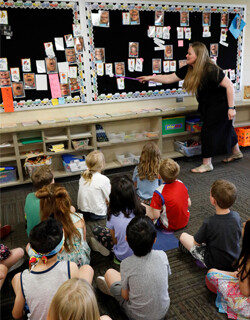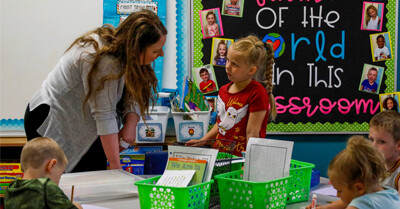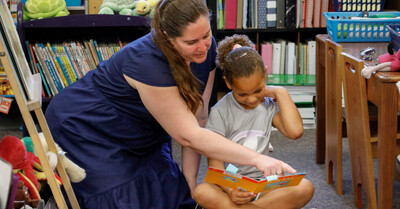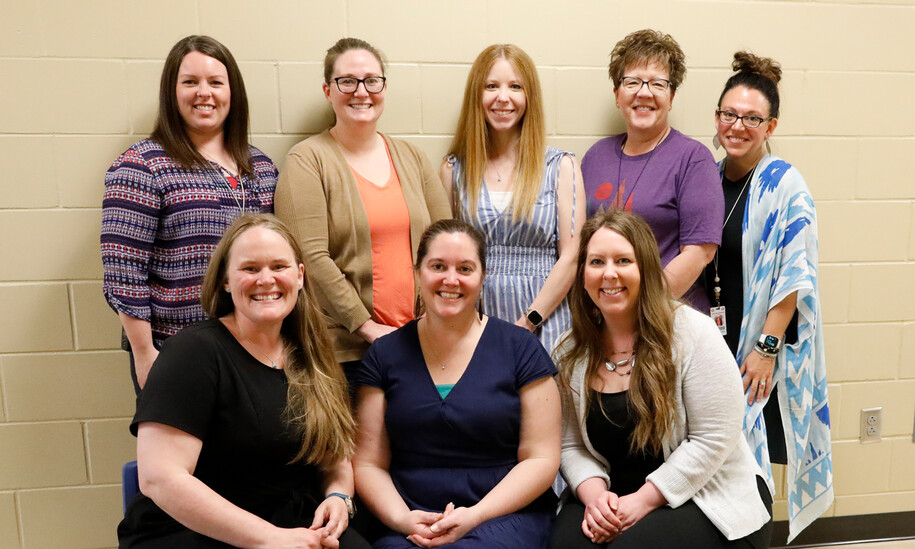Just a few years back, literacy proficiency rates in the kindergarten classrooms of Hansen Elementary School in Cedar Falls hovered in the mid-80s. Respectable? Sure. Unless you consider today’s proficiency rates: They are now hovering around 100 percent. Yes, you read that right.
What’s going on? You don’t need to look any further than kindergarten teacher Kristin Poppens.
It started two-plus years ago when the school’s reading teacher Jennifer Tjaden started challenging Poppens’ approach to literacy instruction.
View photo highlights on Flickr
“I distinctly remember digging my heels in the staff lounge carpet at the very thought of changing my current practices,” Poppens recounted in a podcast she was featured in.
But at the encouragement of Tjaden, she read Equipped for Reading Success by David Kilpatrick. And ideas started clicking in her head.

“It was at that point that I started dabbling in the science of reading,” Poppens said. “I started working intentionally with kids on foundational literacy skills. And then, as a team, we started reading the book together, one chapter at a time. We were working toward having a common understanding of what we felt the kids needed.”
Today, the high-octane team – consisting of Poppens and fellow teachers Marisa Bauer and Jaci Feuss – is entertaining, contagious and highly effective. So what is the team doing? They are taking a science- and evidence-based approach to literacy instruction.
Poppens enlisted the help of Central Rivers AEA Speech-Language Pathologist Heather Monat. From there, they went to town.
“Heather helped us pay attention to the speech articulators – what the tongue, lips and teeth are doing when you make a specific sound.” Poppens said. “We also focused on listening to the voiced and unvoiced sounds.” (To make the “k” and “g" sounds, for example, the position of the articulators is the same, however the voice would remain off for “k” and on for “g.”)
“You also start getting the kids to pay attention to their mouth placement when sounding out a letter,” she said. “We started using mirrors so that they could see their mouths make the right placement,” Bauer said.
“We are in its second full year and there’s been a huge amount of phonemic awareness growth,” Bauer said. “The letter sound mastery was also a huge growth indicator.”
“Last year we had 99 percent proficiency for both the winter and spring assessment periods,” Poppens said. The Hansen team shared their success on the Melissa and Lori Love Literacy podcast. “This year we had 97 percent proficiency!”
“The team is successfully increasing literacy proficiency and demonstrates a shared commitment and consistency in working toward a common goal,” said Leigh Bellville, the literacy consultant at the Iowa Department of Education. “Their ongoing collaboration and support of one another will continue to be a contributing factor ensuring success.”
The teaching approach takes away the guessing element of learning how to read – think of a photo of an elephant with the word “elephant” below. While most students would correctly identify the word as elephant, it’s principally because of the photo, not because they were able to decipher the sound of each letter within the word and then string them together.

“With our approach, students are not guessing,” Poppens said. “They are learning how to be word detectives. They are attending to all letters within a word. They are looking at the internal structure of the word.”
“You have to break down the learning,” Feuss said. “You have to know the rules before you break the rules. For instance, they have to know ‘t’ like the back of their hand before you can teach them ‘th.’ After students have had many, many practice opportunities with basic letter sounds and can use them to read and write, then they can start solving trickier words with new spelling patterns.”
Explicit and systematic instruction in phonics and phonemic awareness paired with intentional practice opportunities for students to read and write is the new norm.
“We originally would just teach the letters and check it one or two times and think, ‘oh, they have it,’” Bauer said. “Now we want them to practice each letter sound hundreds and hundreds of times so they can see the letter and not flinch.”
“Go as slow as you need to, but as fast as you can,” Poppens said. “As Marisa was explaining, we would assess students’ knowledge of skills but we are now assessing towards the mastery and proficiency of letter sounds and phonemic awareness skills. They need multiple repetitions and exposures.”
“We now intervene in phonemic awareness,” Feuss said. “When the school year started, we intervened in the first few weeks in isolating the beginning sounds of words. If we notice that we have kids who can’t hear that dog starts with a ‘d’ sound, then we work on it right away in small groups or individually.”
Poppens said educators should embrace the repetitive nature of foundational literacy skills. Anita Archer, author of Explicit Instruction, states, “Teach the stuff and cut the fluff.”

“Some people get hung up on the ‘drill skill,’” she said. “We are providing practice opportunities just like practicing softball: You are developing a muscle memory with repetition and by incorporating decodable books – as opposed to leveled books.” (Leveled books are characterized and categorized by the level of difficulty of the text.)
Even high achievers – specifically students who start kindergarten already knowing how to read – can get a lot from becoming engaged in foundational literacy skills.
“Those kids know words by sight,” Feuss said. “They see words as full pictures. But they haven’t spent time breaking down words. I have a little guy who was reading from the beginning. But he came across the word ‘humph’ and couldn’t read it. He also couldn’t understand the phrase ‘for land’s sake!’ Given that all of these words are highly decodable and follow phonics rules, it was clear that if he hadn’t seen the word before, he couldn’t figure it out. Now he can. He can see how each word has phonics letter patterns that he can decode. Those types of students are absolutely benefitting from the instruction.
“The way I approach it with them is this: ‘I know you know the word but prove to me why it says that.’ We discuss looking at the word from one syllable to the next syllable in order to figure out words you haven’t come across before. Words like ‘grasshopper’ become accessible because we discuss phonics spelling patterns they understand in order to decode the word.”
When students start putting letters together to form words, it’s important they start small.

“When students know letter sounds like those of ‘a’ and ‘t,’ they can start putting them together to form the word ‘at,’” Feuss said. “Those tiny moments when they read even a small word is so fun! The kids get so excited because they know they are reading.”
“It’s incredible watching the confidence growing in the kids,” Bauer said. “You hear them say, ‘I can do it, I can do it!’ It’s their light bulb moment.”
Poppens said books are created with different purposes in mind. Decodable books are designed to teach decoding whereas leveled books encourage students to guess at words by using the picture and beginning sound of a word. This makes students appear as they are reading, yet students are truly guessing their way through the leveled book. Storybooks are tales meant to be retold and acted out. Content knowledge books build knowledge about the world.
“Leveled books are now retired, collecting dust on bookshelves because they don’t help train students' brains to read,” Poppens said. “Decodable books provide students with quality practice opportunities that reinforce explicit phonics lessons and build muscle memory. Storybooks, such as Goldilocks or The Three Billy Goats Gruff, are stories we hope students know by heart. They love reciting the tales and acting them out during play time. Content knowledge books build oral language vocabulary and student knowledge about science, history and communities.”
So can a school replicate Hansen Elementary’s success?
“Tap into your speech language pathologist,” Poppens said. “She will give you the foundational knowledge. She also will show you the strategies it takes to get kids to use specific sounds.”
This kindergarten team wants all teachers to believe that this is possible in every classroom.
“You can do this, even if you don’t know everything,” Poppens said. “We made tiny changes to our daily instruction and provided lots of purposeful practice for students to gain skills. The small changes we made throughout the year added up to big gains in student success. We had no curriculum or fancy materials. We just leaned on each other and learned together to create success for our students.”
Tips
- Don’t wait for perfection or a deep understanding of the science of reading. Learn a little bit and apply it.
- Have high expectations for all students. Some students require 1-4 repetitions to acquire a new skill compared to other students who need multiple repetitions.
- Provide explicit and systematic whole group instruction for phonics, phonemic awareness, handwriting formation and content building lessons (science and social studies).
- Provide students with multiple opportunities for high-quality practice opportunities: word part building mats, decodable books, continuous blending activities through singing, flashcards that review phonics lessons, word sorts, and incorporate a sound wall.
- Monitor and assess student progress to ensure mastery of letter sounds and phonemic awareness skills. Provide intentional interventions to ensure mastery.
- Irregular words: Specifically in kindergarten, wait to teach irregular words. Introducing irregular words too soon will cause confusion to students’ progress towards mastery of letter sounds.
- Collaboration: seek out experts, such as your reading teacher, occupational therapist, and speech language pathologist. (Here are some tips from our Speech and Language Pathologist Heather Monat.)
- Just as we want students to know the language of mathematics, we want students to know the language of literacy. So, explicitly teach academic language: vowels, consonants, digraphs, r-controlled vowels, schwa (a short neutral vowel sound), open and closed syllables.
- Develop routines and expectations so students can focus their attention on the new skill instead of learning a new routine with each lesson.
Subscribe to receive email updates from the Iowa Department of Education.
